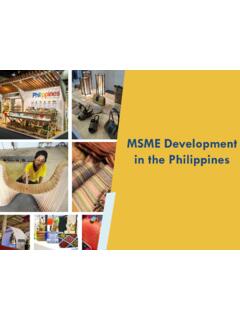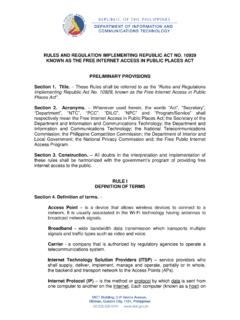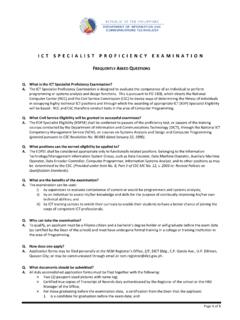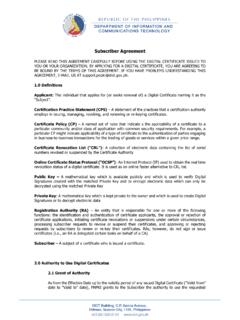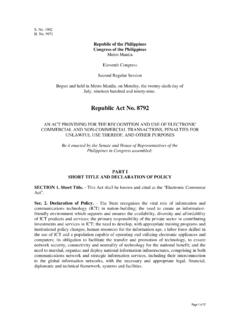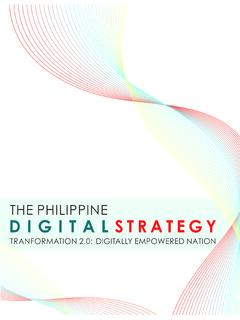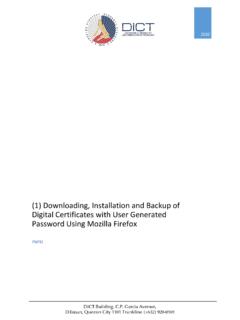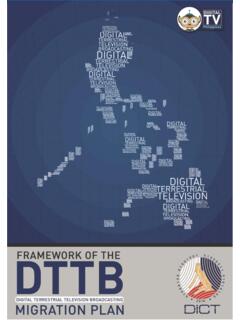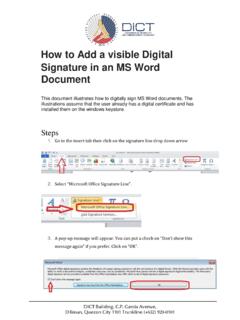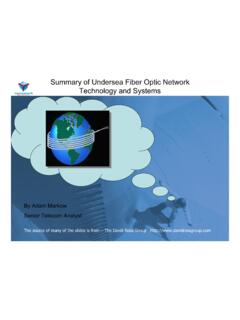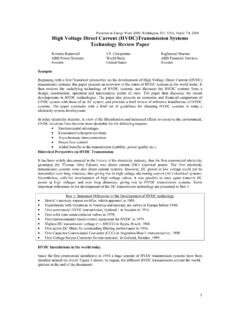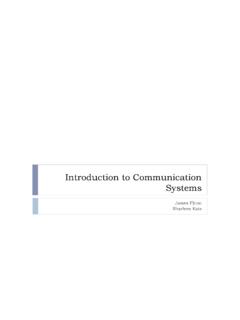Transcription of NATIONAL - DICT
1 NATIONAL BROADBAND PLAN Copyright DICT 2017 Department of Information and Communications Technology Garcia Avenue, Diliman, Quezon City, Philippines 1101 Telephone: (+632) 920-0101 Email address: DICT (2017). NATIONAL Broadband Plan: Building Infostructures for a Digital Nation. Diliman, Quezon City ACKNOWLEDGMENT The Department acknowledges the contribution of the following government agencies, telecommunications companies, internet service providers, equipment and device manufacturers, professional and civil society organizations, among others: Abratique and Associates (A&A) Alcatel-Lucent Philippines Inc. American Chamber of Commerce of the Philippines (AmCham) Asia Cloud Computing Association (ACCA) ATIC Microsoft Better Broadband Alliance (BBA) Mr.
2 Boggs Pimentel Cisco Systems Philippines Comm Trend Construction Corporation (CTCC) Department of Budget and Management (DBM) Department of Education (DepEd) Department of Energy (DOE) Department of Finance (DOF) Department of Interior and Local Government (DILG) Department of Public Works and Highways (DPWH) Department of Tourism (DOT) Department of Trade and Industry (DTI) Department of Science and Technology - Advanced Science and Technology Institute (DOST-ASTI) Department of Science and Technology - Philippine Atmospheric Geophysical and Astronomical Services Administration (DOST-PAGASA) Eastern Communications Fastel Services Federation of International cable Association of The Philippines (FICTAP) Foundation for Media Alternatives (FMA) Globe Telecom House of Representatives (HoR) Huawei IDC Market Research Philippines Information and Technology Association of the Philippines (ITAP) Information Technology Suppliers Association of the Philippines (ITSAP) Institute of Electronics Engineers of the Philippines (IECEP) Integrated Telecommunications Suppliers Association of the Philippines (ITESAP) International Data Corporation (IDC) International Game Developers Association (IGDA) International Telecommunication Union (ITU) Internet Society Philippines Chapter (ISOC PH) Japan International Cooperation Agency (JICA) Kapisanan ng mga Brodkaster ng Pilipinas Mapua Institute of Technology Microsoft Ministry of Internal Affairs and Communications (MIC), Japan NATIONAL Economic and Development Authority (NEDA)
3 NATIONAL Electrification Administration (NEA) NATIONAL Grid Corporation of the Philippines (NGCP) NATIONAL Security Council (NSC) NATIONAL Telecommunications Commission (NTC) NEC Philippines, Inc. Office of Presidential Adviser on Economic Affair and IT Communications Office of the President (OP) Office of Rep. Victor Yap Office of Sen. Paolo Benigno Aquino IV Office of Sen. Sherwin Ting Gatchalian Palo Alto Networks Philippine Association of Private Telecommunications Companies (PAPTELCO) Philippine Association of Government Electronic Engineers (PAGE) Philippine Competition Commission (PCC) Philippine cable Television Association (PCTA), Inc. Philippine Chamber of Telecommunications Operators (PCTO) Philippine Competition Commission (PCC) Philippine Computer Emergency Response Team (PhCERT) Philippine Cooperation Commission (PCC) Philippine Electronics and Telecommunications Federation (PETEF) Philippine Information Agency (PIA) Philippine Internet Freedom Alliance (PIFA) Philippine Investment Fund Association (PIFA) Philippine Investment Funds Association (PIFA) Philippine NATIONAL Police (PNP) Philippine Network Operators Group (PhNOG) Philippine Statistics Authority (PSA) PLDT Inc.
4 Public-Private Partnership (PPP) Center Qualcomm Radius Samsung Electronics Philippines Corporation Sass Smart Data Innovations Senate Committee on Science and Technology Senate of the Philippines SES Sharp Philippines Sumitomo Corporation TAF Philippines Technical Education and Skills Development Authority (TESDA) Transmission Specialists, Inc. (TSI) US-ASEAN Business Council, Inc. Vriens & Partners We are IT Philippines Wi-Fi Interactive Network (WIN) Inc. Zeal Power ZTE Corporation PREFACE Advances in information and communications technologies (ICTs), particularly in broadband technologies, have unlocked numerous socio-economic opportunities for the Philippines. Considered as the fourth utility, broadband has provided substantial efficiencies and innovative solutions cutting across several sectors, thereby magnifying the potential in contributing towards inclusive and sustainable growth of the country.
5 Given the socio-economic benefits that broadband brings, I believe that it is imperative that investments in open, pervasive, inclusive, affordable, and trusted information infrastructures or infostructures should be prioritized. In view of this, the Philippine government, in its desire to accelerate the deployment of fiber optic cables and wireless technologies all over the country, particularly in far-flung or remote areas, to improve the overall internet speed of the country, developed the NATIONAL Broadband Plan (NBP). NBP will provide necessary policy, regulatory and infostructure interventions to ensure the delivery of universal, fast, reliable, affordable broadband internet services to Filipinos in a digital economy. Further, this plan will also ensure the realization of the Philippines long-term vision called AmBisyon Natin 2040 and the country s commitments to the ASEAN ICT Masterplan (AIM) 2020 of improving the quality of life in the country and in the ASEAN region.
6 Indeed, our contract with the Filipino people is foremost in the achievement of the nation s goal of prosperity for all. The Department of Information and Communications Technology (DICT), as the country s primary agency mandated to ensure the universal access to quality, affordable, reliable, and secure ICT services, through the NBP will lay the groundwork for the NATIONAL Governmental Portal (NGP) and the Free WiFi in Public Places, among others by providing the necessary infostructures needed. To ensure timely and effective implementation and monitoring of strategies identified in the NBP, close collaboration with relevant stakeholders (government, industry, academe, civil society, technical organizations, etc.) a necessity. It is with this sense of urgency that the administration advocates for the development of the broadband ecosystem for use of the internet in participatory democracy.
7 With the NBP, the government through the leadership of the DICT shall be the prime mover in building infostructures for a digital nation. RODOLFO A. SALALIMA Secretary, Department of Information and Communications Technology N A T I O N A L B R O A D B A N D PL A N B U I L D I N G I N F O S T R U C T UR E S F O R A D I G I T A L N AT I O N T O P IC A L O U T L IN E ACKNOWLEDGMENT PREFACE ABBREVIATIONS AND ACRONYMS EXECUTIVE SUMMARY i PART ONE: INTRODUCTION 1 Rationale 1 What is Broadband? Why Broadband? How Should Broadband Development Be Supported? Contextualizing Broadband 4 Demographic, Political and Economic Landscape State of Broadband Ecosystem Networks International Connectivity Domestic Connectivity Access and User Devices Adoption and Usage Law, Policies, and Regulatory Issuances that Govern Telecommunications and ICT Competition Ownership Licensing and Permit Spectrum Management Infrastructure Sharing and Interconnection Universal Access and Service PART TWO: REALIZING THE BROADBAND VISION 27 Outcome No.
8 1: Accelerated Investment 29 Review and Develop Laws, Policies, and Regulations Amend Laws, Policies, and Regulatory Issuances that Govern Telecommunications and ICT Issue Open Access and Peering Policy Framework Adopt Standards for Fiber Deployment in Residential and Commercial Areas Institutionalize Building Specification Ratings for Broadband Harmonize Broadband-related Permits, Fees, and Processes Ensure Protection of Critical Infostructure Assets Introduce Incentives to New Market Players to Invest in Unserved Areas Outcome No. 2: Mobilized and Engaged Public and Private Sectors 34 Establish Universal Access and Service Fund Facilitate Infostructure Sharing Leverage Existing Government Infrastructure Assets Institutionalize Dig Once Policy Use the Existing Infrastructure of Utility Companies Outcome No.
9 3: More Places Connected 36 Optimize Spectrum Utilization Repurposing or Recall of Assigned but Unutilized and Underutilized Spectrum Encourage Co-use of Spectrum Implement Dynamic Spectrum Allocation Leverage the Use of Satellite and Emerging Technologies Use Satellite Technologies in Geographically-isolated Areas Accelerate Deployment of TV White Space Technologies Establish the Philippine Integrated Infostructure (PhII) Diversify the Provision of International Connectivity Provide Demand Responsive Domestic Connectivity Outcome No. 4: Increased Take-up Rate 44 Promote New Media, Local Content, and Application Development Conduct Capacity Building and Information Outreach Programs Encourage Communities of Practice (CoP) and Development of Rural Technology Roadmaps Introduce Fiscal Incentives to Broadband Users Strengthen Broadband Performance Monitoring PART THREE: TRACKING PROGRESS 47 PART FOUR.
10 IMPLEMENTATION PLAN 53 Approval of an Issuance of Executive Order for the Adoption and Implementation of NBP 53 Institutionalize Governance Structure for NBP Implementation 53 Develop and Formulate Overall Work and Financial Plan 53 Conduct of Feasibility Studies Call for Proposals and Public Bidding Start of Implementation and Deployment Indicative Timeline of Activities per Outcome 55 Reviewing Progress 57 PART FIVE: COMMUNICATION AND STAKEHOLDERS 59 ENGAGEMENT PLAN Stakeholders Roles and Contributions 59 Government Broadband Network and Service Providers Civil Society Organizations and User Groups Conduct of Promotional Activities or Awareness Campaigns 61 Develop a Website Specific for NBP Implementation Facilitate NATIONAL Stakeholders Forum on the Need for Infostructure Development and Deployment Create Feedback Platforms for Stakeholders Introduce Broadband Service Labeling Conduct Capacity Building Programs GLOSSARY ABBREVIATIONS AND ACRONYMS 2G Second Generation of Mobile Network Technology 3G Third Generation of Mobile Network Technology 4G Fourth Generation of Mobile Network Technology AAG Asia-America Gateway cable System APCN-2 Asia-Pacific Network-2 API Application Program Interface ASE
